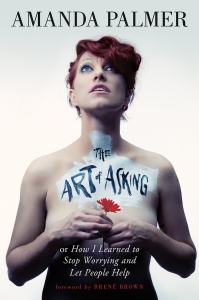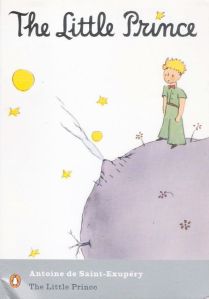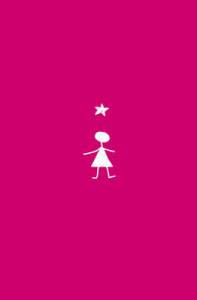Amanda Palmer, Susan Caraway, and Star-People
This has been the most difficult entry to write to date, because there was so much I wanted to say, and I’m still not entirely sure what was the best way of saying it. There is a lot that I wrote and then omitted, because I decided not to include too many spoilers for people who may want to read the books I’m writing about. And also, these books are big, in the sense that they mean a lot to me, which made it even more difficult to write, and made me feel like I needed to add this short introduction. I hope I’ve managed to do these books at least a little bit of justice.
Over the Christmas holidays, I bought and read Amanda Palmer’s The Art of Asking, and finished reading in three days. It reminded me of a book I’ve mentioned on here a few times before; Stargirl, by Jerry Spinelli. There were many connections I made while reading, but this was the biggest one. In The Art of Asking, Amanda Palmer writes about connecting dots. Before I can write about how I now consider Amanda Palmer to be a Star-person, I need to write some background, join some of my own dots, explain where this connection came from.
Amanda writes that at some point in a child’s life, they will start to make connections based on their curiosity about the world around them. She gives the example of noticing how the veins of a leaf look like the patterns on a hand. When I first read it, I thought she was making a link here between a lifelong curiosity and the eventuality of being an artist, but then remembered that making connections and looking for patterns is exactly what scientists do too. An aside: any work undertaken with the aim to broaden knowledge, inspire people, or both, is a form of creativity, whether it is in the arts or the sciences (or both). But that is a whole separate issue that I cannot satisfactorily write about! And besides, this is a blog for books.
Amanda writes about how this dot-to-dot process has influenced the way she pieces her (and often others’) experiences together to create art. This is something that many people automatically do as children, but sometimes lose on the way into adulthood. At this point in my reading, I made another book link, this time with Antoine de Saint-Exupéry’s The Little Prince. I first read this book when I was almost a teenager, and the family friend who let me borrow her copy asked me to let herknow once I’d finished reading if I “got” it.
So I read it carefully, with the expectation that there was going to be something to “get”, and was incredibly disappointed with myself when I got to the end having not seen anything beyond the story itself. Of COURSE the narrator’s childhood drawing was a snake that had eaten an elephant, why shouldn’t it be? And it was obvious that the businessman at his desk on his tiny planet was never going to be able to enjoy the stars he owned unless he left his desk, and looked at and saw them properly. Thoroughly disappointed with myself, I think I made something up. It wasn’t until a long time afterwards that I saw the book again, and realised what it was trying to say. There are people who might read the book as adults and forget that as a child they thought: “if you refuse to write about ephemeral details like the rose, then why even write about the planet at all?” Amanda is one of those lucky people who will always want to write about the rose, no matter how old or exposed to cynicism she gets.
This thought stayed with me as I read the rest of the book, and made its inevitable way towards Stargirl.
Stargirl by Jerry Spinelli is a book that I’ve read once a year since first reading it at thirteen years old, and is one of those wonderful books in which you discover something new every time you re-read it (re-reading is something that I do relatively often, and is a whole other blog post in itself). Stargirl Caraway changes her name whenever she outgrows her old one. She arrives at Leo Borlock’s high-school wearing floor-sweeping skirts, carrying a sunflower bag and a ukulele, with which she serenades the other students on their birthdays. Her best friend is a pet rat called Cinnamon, who hitches a ride to school every day in her canvas bag. It’s easy to dismiss this kind of person as a fake, an attention seeker (as a couple of the more cynical students in the school do), but it is gradually revealed to Leo and the reader that she is genuine. It is this genuine eagerness to notice everyone and make everyone feel seen that eventually leads her to a brief spell of unhappiness, through which she perseveres and emerges on the other side, loved and finally accepted.
Amanda, in her book, makes a point about how not everyone wants to be looked at, but everybody wants to be seen. She invited unknown musicians to share stages, she crowd-sourced information and advice while writing her book, she celebrates the small victories of her fans, and tries to spread her happiness and her love for everyone as far as she can. Stargirl applauds schoolchildren in the hallways when they pick up litter dropped by the other kids. Amanda Palmer wrote “a poem for dzhokar“, an empathic piece of writing in which she channels love and comfort and understanding at everybody affected by the Boston bombings. She asked her fanbase for help in funding her next record, who then completely smashed the Kickstarter target. She continued to ask musicians to volunteer to play at her gigs, because that’s what she has always done, and that’s how she has always helped local musicians. Inevitably (and sadly), these events led to a barrage of hatred. How dare she write a sympathetic poem about a boy desperate enough to commit such a terrible act of terrorism? How dare she invite musicians to play with her, for free, even after taking so much money from her fans? How dare someone have so much empathy and continue to offer support to others who may never get it from somewhere else.
There is a scene in Stargirl that takes place at a school basketball match. At this point, the majority of the school loves her. She has provided them with a team spirit they never knew they had, and as such, she has been made a cheerleader. SHe cheers for her own team, and, bizarrely, she cheers for the other team too. Just as she celebrates small victories in school, she celebrates the victories of anyone who does well on the basketball court. The school’s sports teams have never before won anything, and now their basketball team has more support than ever and is actually winning. At this match, however, they are beginning to lose. The other team has an incredible star-player who is single-handedly winning the match, making the new-to-winning school start to panic. They have forgotten how to lose, and begin booing their own team, and Stargirl’s cheering for the other team begins to be not so endearing any more. The other team’s star-player is suddenly injured. Of course, the first person onto the court to comfort the injured player is Stargirl. Not only has she cheered for the other team, but she is down there, comforting the enemy, holding his head in her lap while the medics make their way over. This is unforgivable, and culminates in a process in which Stargirl turns back into Susan, tones down the empathy and the affection, and makes herself thoroughly miserable.
Stargirl’s mentor is an old palaeontologist and teacher, Archie. Archie explains later to Leo that Stargirl is a star-person, and star-people are very rare people who manage to hold on to that same way of viewing the world as The Little Prince does. Like Amanda Palmer, Stargirl is the kind of person who would notice and love all of the ephemeral details like the rose. Empathy and the power to observe the world around you from all kinds of different viewpoints are amazing qualities to have, and I feel lucky to have been exposed to three books that deal with it explicitly and without being too self-aware or preachy. They are genuine, and that is what draws you to them and makes you love them, and makes you want to learn to be more like them, these strong individuals who refuse to stop trying to help people understand each other. They want people to be kind, and talk to each other, or at least get to a point where they can tolerate others’ beliefs. Most importantly, they listen, and they never stop learning.
Without sounding too much like a gushing fangirl, I believe Amanda Palmer is a star-person. She isn’t superhuman, she makes mistakes, I’m sure. But what makes her like Stargirl is her ability to acknowledge everybody else, to see everybody else, and her genuine need to try and understand all of the different points of view thrown in her direction. It’s why she became so sad when the internet hate appeared, and journalists kept getting her story wrong, because like the lamplighter encountered by the Little Prince, they had mindlessly continued with their job, theirs being trying to bait viewers with scandalous, badly researched articles. As quoted in the blurb of Stargirl, “She was elusive. She was today. She was tomorrow. She was the faintest scent of a cactus flower, the flitting shadow of an elf owl. We did not know what to make of her. In our minds we tried to pin her to corkboard like a butterfly, but the pin merely went through and away she flew.”
Dear Amanda,
If you ever read this, thank-you, and I really recommend that you read Stargirl. It’s a story about empathy and sharing kindness, and you come across as being all about that kind of thing. And from what you write about Anthony, I’m sure he is your Archie.
Lots of love,
Adelle.



